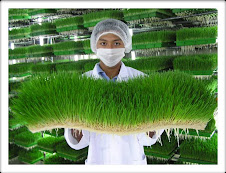I'd like to thank my friend Vic Milan who shared this testimonial from one of his listeners. Vic has a radio program called Kalikasan Vigilante, which airs Mondays to Fridays from 7:15pm to 8:30pm at 104.3FM - Wheatgrass Man
A LUPUS SURVIVOR’S STORY
BY MARIA CHRISTINA M. CASTILLEJOS
BY MARIA CHRISTINA M. CASTILLEJOS
(23 Years Old)
"I was in second year college in 2003 when I was diagnosed with Lupus Nephritis (Class 4). I was hospitalized for more than one month. Two years later, after a seizure, the diagnosis was even more stunning: I had Lupus Cerebritis, which means that the disease had reached my brain. I was also told I could no longer go back to school. I was so devastated I just wanted to die.
I was told to see a psychiatrist so I could accept the fact that lupus would forever be in my system. I did not follow the suggestion. I was determined, and I began to believe in my heart, that prayers and research would help me find a cure.
Lupus is a disease where the immune system goes on a rampage, attacking even healthy cells, resulting in severe damage to my kidneys, lungs and hemoglobin count. In my case this happened whenever I experienced pressure and depression. I was hospitalized three times for long periods, put under heavy medication all the while, and the effect on my family’s finances was just as devastating.
Subjected to all kinds of procedures, my body became almost immune to pain. One procedure involved taking out 4 liters of liquid from my lungs… it was so painful I wished for death just to escape the pain, but I just let them do it anyway. My pain threshold went up some more, and during another open surgery I was awake during the whole procedure because the anesthesia no longer had any effect on me… possibly also because of all the drugs that had been given to me.
In 2007, they started giving me 5000 units of Recormon injection due to very low hemoglobin count. (Normally, blood count is at 12-17 G/DL; mine went down to 8.1 G/DL) which caused me to have shortness of breath and weakness almost to the point of collapsing. I could not sleep well. Black circles began to form under my eyes and other sensitive parts of my body. Also at this time my mother was suffering from slight anemia and symptoms similar to mine.
Then one evening while she was listening to her favorite radio station, she heard about wheat grass and its health benefits when taken regularly. She immediately contacted the person in the radio program to ask where she could get the grass.
Just two days after taking the said grass, she felt strong and was relieved of feeling weak after just minor household chores. She then encouraged me to take it also and see if it could help me. However, my doctor said I should not take it because it might conflict with my other medicines and that it might harm my kidneys.
My mother was so persistent and suggested that I should try the wheatgrass without stopping my medicines. I started taking two sachets a day for two weeks. I stopped my injection then so we could observe the effect of wheatgrass.
In just two weeks I started feeling so fantastic. I felt strong, my sleeping improved and my dizziness was gone. I had my hemoglobin count tested again and the result was amazing: it had gone up from 8.1 to 12 G/DL (normal) and my creatinine was normal.
My doctor was surprised. We had not told her I was taking wheatgrass. She must have thought it was due to Recormon injections and other maintenance medicines.
After just six months of daily wheatgrass intake, I am testing negative for protein, my pus cells normal… no more urinary tract infection (UTI) though all these past years I had been taking high dosages of antibiotics for UTI. My doctor continues to be surprised at my progress; I should be out of steroids soon. I am praying that with this new non-synthetic food supplement I will continue to improve and completely heal my disease and I will be normal again to continue my studies. I feel very strong now and am more confident because I have not had any attack the past six months.
I am now allowed to study at the University of the Philippines home-stay program. I now have a temporary job in the day time to test my endurance and ability to cope with pressure. I want to finish my studies so I can find a permanent job so I can continue my regular dosage of wheatgrass.
I will take this product forever and have recommended it to other lupus victims like me. "
"I was in second year college in 2003 when I was diagnosed with Lupus Nephritis (Class 4). I was hospitalized for more than one month. Two years later, after a seizure, the diagnosis was even more stunning: I had Lupus Cerebritis, which means that the disease had reached my brain. I was also told I could no longer go back to school. I was so devastated I just wanted to die.
I was told to see a psychiatrist so I could accept the fact that lupus would forever be in my system. I did not follow the suggestion. I was determined, and I began to believe in my heart, that prayers and research would help me find a cure.
Lupus is a disease where the immune system goes on a rampage, attacking even healthy cells, resulting in severe damage to my kidneys, lungs and hemoglobin count. In my case this happened whenever I experienced pressure and depression. I was hospitalized three times for long periods, put under heavy medication all the while, and the effect on my family’s finances was just as devastating.
Subjected to all kinds of procedures, my body became almost immune to pain. One procedure involved taking out 4 liters of liquid from my lungs… it was so painful I wished for death just to escape the pain, but I just let them do it anyway. My pain threshold went up some more, and during another open surgery I was awake during the whole procedure because the anesthesia no longer had any effect on me… possibly also because of all the drugs that had been given to me.
In 2007, they started giving me 5000 units of Recormon injection due to very low hemoglobin count. (Normally, blood count is at 12-17 G/DL; mine went down to 8.1 G/DL) which caused me to have shortness of breath and weakness almost to the point of collapsing. I could not sleep well. Black circles began to form under my eyes and other sensitive parts of my body. Also at this time my mother was suffering from slight anemia and symptoms similar to mine.
Then one evening while she was listening to her favorite radio station, she heard about wheat grass and its health benefits when taken regularly. She immediately contacted the person in the radio program to ask where she could get the grass.
Just two days after taking the said grass, she felt strong and was relieved of feeling weak after just minor household chores. She then encouraged me to take it also and see if it could help me. However, my doctor said I should not take it because it might conflict with my other medicines and that it might harm my kidneys.
My mother was so persistent and suggested that I should try the wheatgrass without stopping my medicines. I started taking two sachets a day for two weeks. I stopped my injection then so we could observe the effect of wheatgrass.
In just two weeks I started feeling so fantastic. I felt strong, my sleeping improved and my dizziness was gone. I had my hemoglobin count tested again and the result was amazing: it had gone up from 8.1 to 12 G/DL (normal) and my creatinine was normal.
My doctor was surprised. We had not told her I was taking wheatgrass. She must have thought it was due to Recormon injections and other maintenance medicines.
After just six months of daily wheatgrass intake, I am testing negative for protein, my pus cells normal… no more urinary tract infection (UTI) though all these past years I had been taking high dosages of antibiotics for UTI. My doctor continues to be surprised at my progress; I should be out of steroids soon. I am praying that with this new non-synthetic food supplement I will continue to improve and completely heal my disease and I will be normal again to continue my studies. I feel very strong now and am more confident because I have not had any attack the past six months.
I am now allowed to study at the University of the Philippines home-stay program. I now have a temporary job in the day time to test my endurance and ability to cope with pressure. I want to finish my studies so I can find a permanent job so I can continue my regular dosage of wheatgrass.
I will take this product forever and have recommended it to other lupus victims like me. "










